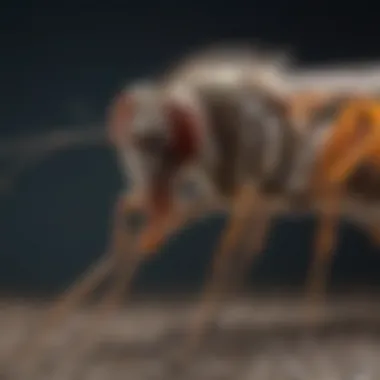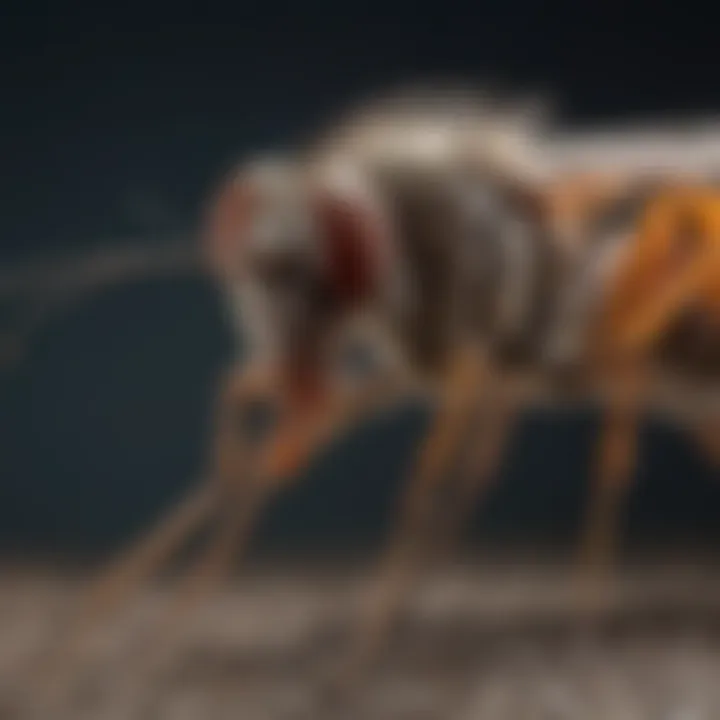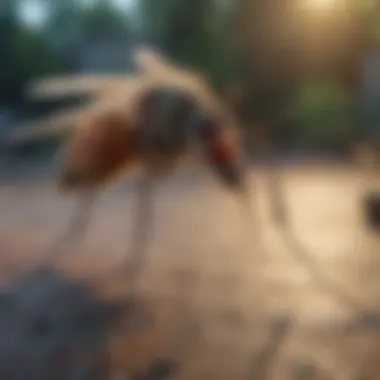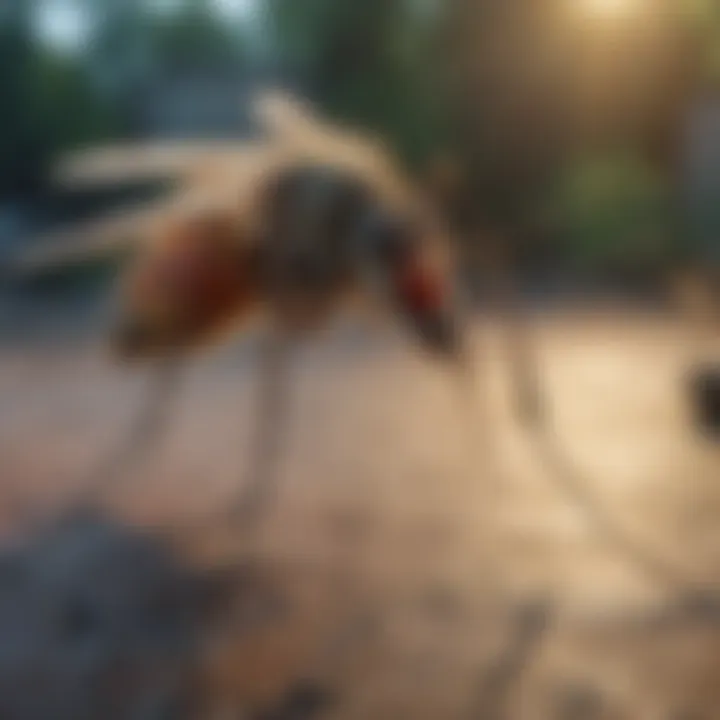Advanced Strategies for Effective Mosquito Management


Intro
Mosquito management is both a pressing concern and a complex challenge for homeowners and pest control professionals alike. Given the ecological role of mosquitoes and the potential health risks they pose, understanding effective management systems is crucial. This article outlines key insights into managing mosquito populations, focusing on various strategies and innovative technologies that suit both residential and community needs. By gaining a thorough understanding of mosquito behavior and the various control methods, stakeholders can mitigate risks associated with these pests while maintaining ecological balance.
Understanding Pests
Definition of Pests
Pests are organisms that disrupt human activities, damage crops, or generate diseases. In this context, mosquitoes fall squarely within this definition. They are small, flying insects known for their biting habits and role as vectors for numerous diseases. They can affect quality of life, disrupt outdoor activities, and even pose serious health hazards.
Importance of Pest Identification
Identifying specific pests is essential for deploying suitable management strategies. Misidentification can lead to ineffective treatments and wasted resources. In the case of mosquitoes, knowing species can guide homeowners in understanding behavioral patterns and, consequently, the most effective methods for control. For instance, different species may have varying breeding habits and habitats, making it essential to recognize them accurately.
Prevention Techniques
Home and Garden Preventative Measures
Preventing mosquito infestations requires a multifaceted approach. Homeowners ought to take definitive steps in their immediate surroundings. Here are some effective practices:
- Eliminate Standing Water: Mosquitoes breed in stagnant water. Regularly check for areas in the yard where water collects.
- Maintain Gutters: Ensure gutters are clean and draining properly to avoid pooling water.
- Use Window Screens: Installing fine mesh screens can prevent mosquitoes from entering living spaces.
- Properly Fertilize Gardens: Over-fertilization can lead to water accumulation in soil, providing breeding grounds.
Seasonal Prevention Tips
Timing plays a significant role in mosquito management. Here are some seasonal tips to consider:
- Spring: Begin inspections for standing water and treat breeding areas proactively.
- Summer: Use repellents during outdoor activities. This is peak mosquito season.
- Fall: Continue to drain water and consider barriers as temperatures drop.
Eco-Friendly Pest Control Solutions
Overview of Sustainable Practices
Sustainable pest management emphasizes harmony with nature. Methods that reduce chemical usage can also safeguard beneficial insects. Common sustainable practices include:
- Biological Control: Introducing natural predators can control mosquito populations. For example, some fish consume mosquito larvae.
- Habitat Modification: Altering the landscape can make it less hospitable for mosquitoes. This could mean changing water drainage patterns in gardens.
Natural Remedies and Their Effectiveness
Natural remedies have gained popularity as alternatives to chemical solutions. Popular options include:
- Essential Oils: Oils like citronella and lavender have been shown to repel mosquitoes.
- Garlic Spray: Some studies suggest that garlic can deter these pests.
While natural methods may not be as immediate in effect as chemical treatments, they often provide a safer long-term solution that benefits the overall garden ecosystem.
“Understanding mosquito behavior and ecology is crucial for effective control and management. It is not just about eliminating a nuisance; it is about maintaining ecological integrity.”
Preface to Mosquito Management
Mosquito management is an essential topic as it intertwines public health, environmental science, and community engagement. Understanding how to effectively manage mosquito populations can mitigate risks associated with their presence. This involves taking into account various factors like ecology, disease prevention, and control measures that collectively shape the effectiveness of management strategies.
Understanding the Problem
The presence of mosquitoes is not merely an inconvenience. These insects are vectors for several diseases that pose significant health risks to humans. The global increase in mosquito-borne diseases is alarming, with examples such as dengue fever, malaria, and Zika virus on the rise. This surge can be attributed to several factors including climate change, urbanization, and changing land use patterns. These elements create conditions favorable for mosquitoes to thrive, making understanding their life cycles and habitats crucial for effective control.
Recognizing the problem requires thorough knowledge of how mosquitoes reproduce and where they breed. Standing water is often a breeding ground. It becomes imperative for homeowners to identify and eliminate these areas to diminish the mosquito population effectively.
Importance of Mosquito Control
The importance of mosquito control stretches beyond the nuisance they cause. With the ability to transmit life-threatening diseases, effective mosquito management is critical for safeguarding public health. By implementing control strategies, communities can reduce disease transmission rates, lowering healthcare costs and protecting vulnerable populations.
Moreover, addressing mosquito issues contributes to enhanced quality of life. Outdoor activities can be enjoyed without the constant annoyance of bites, enabling a more pleasant as well as healthier environment.
In addition to the health sector, successful mosquito management also has economic implications. Areas that experience fewer mosquito-related issues tend to attract more visitors. Thus, investing in mosquito control solutions benefits not just health but can also boost local economies.
"Engaging in proactive mosquito management not only protects individual health but also promotes community wellness."
As we advance through this article, the focus will be on dissecting each element of mosquito management systems. From understanding the ecology of mosquitoes to exploring innovative technologies, the narrative aims to equip homeowners, gardeners, and pest management professionals with the strategies necessary to combat mosquitoes effectively.
Ecology of Mosquitoes
Understanding the ecology of mosquitoes is crucial for effective management systems. It involves studying their life cycles, habitat preferences, and interactions with the environment. Recognizing these ecological factors helps develop targeted control measures. When we understand how mosquitoes thrive, we can create environments that minimize their populations. This section provides an insightful look at the life cycle of mosquitoes and their preferred habitats.
Life Cycle of Mosquitoes
The life cycle of mosquitoes consists of four distinct stages: egg, larvae, pupae, and adult. Each stage plays a significant role in the proliferation of mosquitoes and their persistence in various environments.


Egg
Mosquito eggs are typically laid in or near water. One key characteristic of the egg stage is its ability to withstand dry conditions. This allows the eggs to remain dormant until the right conditions return, making them resilient. Their unique feature is the ability to hatch soon after rainfall or water accumulation. While it ensures population continuity, it also makes management challenging, as eggs can lie in wait for long periods. Understanding this stage helps to focus on effective timing for treatments.
Larvae
In their larval stage, mosquitoes are aquatic and feed on organic matter and microorganisms in the water. This phase is critical for growth. The larvae can be observed hanging just below the water surface, where they filter-feed. One key characteristic is their need for clean, sheltered water bodies. This specificity makes larvae vulnerable to management efforts. Targeting this stage can significantly reduce populations since larvae cannot survive in disturbed habitats or polluted water. Effective strategies during this stage are crucial in achieving control goals.
Pupae
Pupae represent the transitional stage in the mosquito life cycle. They are also aquatic but do not feed. This stage is where the larva transforms into an adult mosquito. The significant aspect of pupae is their vulnerability; while they may seem inactive, they are preparing for emergence. Their unique feature is that they can be sensitive to environmental changes, such as water temperature. Managing pupae through water body maintenance can help in reducing future adult populations.
Adult
Adult mosquitoes are the most recognized stage due to their active role in seeking blood meals and transmitting diseases. The adult phase is when they impact human health significantly. A key characteristic of adult mosquitoes is their ability to disperse over large areas in search of breeding grounds. Their unique feature includes a relatively long lifespan, depending on environmental conditions. Understanding adult behaviors aids in the development of targeted traps and deterrents, marking this stage as vital for overall management strategies.
Habitat Preferences
Mosquitoes have specific habitat preferences that directly impact their lifecycle and distribution. Understanding these environments is important for effective control strategies.
Freshwater Sources
Freshwater sources, such as ponds and rivers, provide ideal breeding grounds for mosquitoes. Their key characteristic lies in their preference for unpolluted water, which supports larval development. These bodies of water can become hotspots for mosquito populations. The advantage of focusing on these areas is clear; reducing stagnant areas or maintaining cleanliness can minimize mosquito breeding potential. However, ecosystems in these areas can be complex, requiring careful management to avoid disrupting local biodiversity.
Stagnant Water Bodies
Stagnant water bodies, such as tires, containers, and clogged gutters, are also prominent breeding sites. The critical aspect of these habitats is their ability to retain water without flow, creating ideal conditions for mosquito eggs to hatch. One unique feature is their accessibility in urban settings, making them easily targeted for removal. The disadvantages arise when such habitats are numerous, as complete elimination can be challenging. Ongoing management efforts are essential to mitigate these risks.
Urban Environments
Urban environments have become increasingly conducive for mosquito breeding due to human activities. These areas often combine various potential breeding grounds, including pools, birdbaths, and wastewater. A key characteristic is the close proximity of human populations to breeding sites, which elevates the risk of disease transmission. The advantage of targeting urban environments is the opportunity for community awareness and engagement. However, the complexity of urban landscapes may necessitate more sophisticated control measures to be effective.
Health Risks Associated with Mosquitoes
Mosquitoes are more than just a nuisance; they pose significant health risks to humans. Understanding these health risks can guide effective mosquito management strategies. This section will focus on the diseases transmitted by mosquitoes and their impact on public health. It highlights the need for timely and targeted mosquito control efforts to mitigate the risks associated with these vectors. Knowledge of these health concerns is crucial for both individuals and communities aiming to reduce mosquito populations and disease transmission.
Diseases Transmitted by Mosquitoes
The transmission of diseases by mosquitoes is a pressing global health issue. Below are key diseases that highlight the serious risks posed by these insects.
Dengue Fever
Dengue fever is a viral illness transmitted by the Aedes aegypti mosquito. This disease is significant due to its rapid spread in tropical and subtropical climates. One major characteristic of dengue is its potential to develop into severe forms, including dengue hemorrhagic fever, which can be fatal. The increase in cases over recent years in urban areas makes it relevant for the discussion on mosquito management. Dengue's unique feature is its cyclical outbreaks, linked closely to climatic conditions, which can create challenges for prevention and control efforts.
Zika Virus
Zika virus, also spread by Aedes mosquitoes, gained notoriety due to its association with birth defects when contracted during pregnancy. It is particularly concerning because it often results in mild symptoms, leading many to overlook its severity. Zika is significant in this discussion because it has changed public health responses globally, emphasizing the need for effective mosquito control practices. Its unique aspect is that it can be transmitted sexually, further complicating management strategies.
West Nile Virus
West Nile virus is primarily transmitted by Culex mosquitoes. It has a wide distribution, affecting various regions across multiple continents. The main concern with West Nile virus is its potential to cause severe neurological disease in a small percentage of those infected. This makes it vital to highlight in discussions on public health. The unique feature of this virus is its ability to leverage bird populations as reservoirs, which complicates control efforts. This interdependence magnifies the importance of integrated management strategies.
Malaria
Malaria remains one of the deadliest mosquito-borne diseases, primarily transmitted by Anopheles mosquitoes. Its foothold in many developing regions makes it a priority in health discussions. Malaria's key characteristic is its complex life cycle, involving both mosquitoes and humans. Effective management of malaria requires addressing these life cycle stages. An essential feature of malaria is the development of drug resistance, which poses challenges for treatment. Thus, continuous research and community involvement in prevention efforts are crucial.
Impact on Public Health
The impact of mosquito-borne diseases on public health is profound and multifaceted. Increased hospitalizations, economic burdens, and loss of productive years are direct consequences. Communities often face challenges in implementing effective control measures due to a lack of resources or public awareness. Addressing these health risks necessitates a collaborative approach that involves local governments, health organizations, and the public. Awareness campaigns and preventative measures can significantly reduce the incidence of these diseases, emphasizing the need for an integrated management approach in mosquito control efforts.
Traditional Mosquito Management Techniques
Traditional mosquito management techniques have played a vital role in controlling mosquito populations and reducing the incidence of diseases transmitted by these pests. These approaches are essential for both residential settings and larger community efforts. They typically focus on prevention and immediate intervention strategies that have been proven over time to be effective.
Source Reduction
Source reduction is often seen as the cornerstone of traditional mosquito management. It involves modifying the environment to eliminate the conditions that allow mosquitoes to thrive. The main goal is to disrupt their breeding cycle, thereby reducing their numbers in the long term.
Eliminating Standing Water
A key aspect of eliminating standing water is its efficiency. Mosquitoes need stagnant water to lay their eggs. By ensuring that water does not accumulate in containers, yards, or other areas, homeowners can significantly decrease mosquito populations. This approach is beneficial because it is low-cost and low-maintenance.
However, the challenge lies in the need for constant vigilance. Unattended water sources can appear quickly after rain or flooding. Homeowners must regularly check and manage their properties accordingly.
The unique feature of this method is its preventive nature. Once standing water is removed, the breeding cycle of mosquitoes is interrupted. This advantage strengthens the case for source reduction as one of the most effective traditional methods.
Water Management Practices


Water management practices involve using strategies and tools to manage water sources effectively. This can include the maintenance of drainage systems, ensuring proper water flow in ditches, and regularly cleaning water features such as ponds to prevent them from becoming breeding sites. This idea is beneficial as it minimizes reliance on chemical treatments, which can have detrimental effects on the environment.
A unique characteristic of water management practices is their adaptability. They can be tailored according to specific environmental conditions. However, these practices do require a time investment and may involve coordinated efforts among neighbors or local authorities to achieve desired results.
Chemical Controls
Chemical controls, while often seen as a last resort, are crucial in managing larger infestations effectively. These techniques involve the application of products specifically designed to kill or repel mosquitoes. The effectiveness of these chemicals often provides immediate results, making them a popular choice in mosquito control plans.
Pesticides
Pesticides are perhaps the most well-known chemical control method. They work by targeting various life stages of mosquitoes, from larvae to adults. Their popularity stems from their rapid effects, which can lead to dramatic reductions in mosquito populations.
However, the unique feature of pesticides is their potential side effects. Overuse can lead to resistance among mosquito populations, diminishing their effectiveness over time. Additionally, environmental concerns arise due to potential harm to non-target species. Careful application and adherence to safety guidelines are essential to mitigating these risks.
Insect Growth Regulators
Insect growth regulators (IGRs) provide an alternative approach to traditional pesticides. They work by interfering with the normal development of mosquitoes, preventing them from maturing into adults. IGRs are an effective choice for long-term control because they do not kill adult mosquitoes immediately, which helps conserve beneficial insects.
The unique feature of IGRs is their targeted mechanism. They primarily affect the larval stages, allowing for a more environmentally friendly approach compared to broad-spectrum insecticides. However, reliance solely on IGRs may not be sufficient in controlling large populations, and they are best used in conjunction with other strategies for optimal impact.
Innovative Mosquito Management Technologies
Innovative mosquito management technologies represent a pivotal shift in the approach to controlling mosquito populations and mitigating their associated health risks. The evolution of these technologies aims to provide more effective and sustainable solutions in the face of rising mosquito resistance to traditional methods. The integration of advanced scientific techniques not only enhances control measures but also considers environmental impacts. This section discusses two prominent innovative strategies: genetic control methods and biological control agents, both of which show promise in altering the dynamics of mosquito populations.
Genetic Control Methods
GMO Mosquitoes
GMO mosquitoes entail the genetic modification of mosquito species to reduce their populations. One significant aspect of GMO mosquitoes is their ability to carry genes that suppress reproduction. The introduction of modified males into the wild can lead to a decrease in the number of mosquitoes over time, as these males mate with wild females, resulting in offspring that do not survive to adulthood.
The key characteristic of GMO mosquitoes is their capacity to significantly lower the mosquito population without extensive use of pesticides. This approach is attractive because it offers a sustainable solution to buggy issues. A unique feature of GMO mosquitoes includes their targeted effects, which specifically aim at species like Aedes aegypti that transmit diseases such as dengue and Zika.
The advantages of this method lie in its ability to reduce mosquito populations with less environmental impact compared to chemical pesticides. However, public acceptance and regulatory hurdles are challenges that may limit the widespread application of this technique.
Sterile Insect Technique
The Sterile Insect Technique (SIT) involves the release of sterilized male mosquitoes into the environment to control populations. An important aspect of SIT is that it operates on the principle of biological control, relying on mating behaviors to achieve its goal. Sterilized males mate with wild females, and the result is a decrease in the number of progeny since fertilization does not occur.
The key characteristic of SIT is its focus on mating competition rather than chemical means. This approach is beneficial as it maintains the ecological balance while controlling mosquito populations. A unique feature of SIT is its site-specific targeting, ensuring that only certain populations are affected, minimizing impacts on non-target species.
The advantages include a reduced likelihood of developing insecticide resistance and a lower environmental footprint. On the downside, SIT may require a well-structured plan for implementation and extensive monitoring to ensure effectiveness.
Biological Control Agents
Predatory Fish
Predatory fish serve as natural biological control agents in managing mosquito populations. These fish consume mosquito larvae, thereby reducing their numbers in aquatic habitats. A notable aspect of using predatory fish is their ability to thrive in various water bodies, making them flexible and effective in different settings.
The key characteristic of predatory fish is their biological role in the food web, wherein they act as a natural regulator of mosquito populations. This biological control method is advantageous as it is non-invasive and enhances biodiversity. However, one must consider the potential ecological disruption that introducing non-native species might cause.
Bacteria and Fungi
Bacteria and fungi provide another innovative approach to mosquito control. Certain strains of bacteria, such as Wolbachia, can infect mosquitoes, reducing their ability to transmit viruses. This aspect emphasizes the use of disease-managing tools that modify mosquito physiology. These microorganisms can provide a natural, self-limiting population control method.
Bacteria and fungi’s unique feature is their mode of infectivity, which may lead to a decrease in mosquito populations without relying on chemicals. The benefit of using these agents lies in their specificity and relatively low environmental impact. However, challenges include ensuring the persistence of these agents in the environment and public comprehension of their use.
The integration of innovative mosquito management technologies is crucial for a sustainable approach to controlling mosquito populations effectively.
With advancements in both genetic control methods and biological agents, there is potential for a more effective and ecologically sound strategy in the fight against mosquito-borne diseases.
Community Involvement in Mosquito Management
Community involvement is critical in the management of mosquito populations. Effective mosquito control goes beyond the actions of individual households or pest management professionals. It requires a concerted effort from the entire community. When individuals become engaged in mosquito management, the impact can be substantial. Communities that participate actively can reduce mosquito breeding sites and ultimately lower the risk of mosquito-borne diseases.
Engaging the public in mosquito management can take various forms. First, it fosters a sense of shared responsibility and awareness. When community members collaborate, they create an environment that prioritizes health and safety. This collective action ensures that mosquito control strategies are more successful and sustainable. The benefits of community involvement include increased knowledge among residents, accountability for personal actions, and enhanced communication between local authorities and the public.
Involvement of residents also permits the identification of unique breeding sites within neighborhoods that might not be documented in official surveys. Local knowledge can be invaluable.
Public Awareness Campaigns
Public awareness campaigns are a powerful tool for educating communities about the importance of mosquito management. These campaigns can inform citizens about the behaviors of mosquitoes, the diseases they transmit, and effective prevention strategies. For example, distributing flyers, utilizing social media, or hosting community workshops can effectively spread important information.
Such campaigns often emphasize the necessity of eliminating standing water, as this is where mosquitoes breed. Educating residents about simple practices, such as regularly cleaning out gutters or emptying containers that hold water, can make a significant difference.
Moreover, successful campaigns tend to use relatable language and visual aids in their promotions. This approach not only boosts understanding but also encourages participation from people of different backgrounds and ages. Adding testimonials or case studies can further engage the community by showing tangible results from their efforts.


Community Cleanup Initiatives
Community cleanup initiatives are an essential aspect of mosquito management that involve direct action. By organizing neighborhood cleanups, communities can physically address areas that may serve as mosquito breeding grounds. Removing debris, trash, and stagnant water can reduce local mosquito populations.
Encouraging volunteers to participate enhances community spirit. It provides ownership of the issue while improving local environments. Cleanup events can be fun and effective, especially when they involve families or local organizations.
Establishing regular cleanup schedules can help maintain the effort, creating a long-term strategy that addresses the mosquito problem. Additionally, these initiatives can be paired with other educational components to remind participants about the importance of their actions in mosquito management.
Evaluating the Effectiveness of Mosquito Management Systems
Evaluating the effectiveness of mosquito management systems is essential. It provides an insight into how well the methods work to control mosquito populations and mitigate health risks. Effectiveness can directly impact public health outcomes and inform future strategies. By understanding what works and what does not, communities can allocate resources more efficiently, making informed decisions.
Monitoring Mosquito Populations
Monitoring mosquito populations is crucial in any effective management system. Data on population density helps in assessing the current situation and guiding control efforts.
Trap Methods
Trap methods are a widely used strategy to monitor mosquito populations. These methods typically involve various types of traps that capture mosquitoes for identification and counting. One key characteristic of trap methods is their ability to provide real-time data about mosquito species and numbers. This immediate feedback is beneficial for understanding local mosquito ecology and targeted control strategies.
A unique feature of trap methods is their diversity; options range from simple sticky traps to more complex CO2-baited traps. Each type has its advantages and disadvantages. For instance, sticky traps are easy to deploy but may not capture all mosquito species. On the other hand, CO2-baited traps are more effective at attracting a wider variety of species, but they require more setup and maintenance.
Surveillance Technologies
Surveillance technologies have advanced, enabling more efficient tracking of mosquito populations. They can involve remote sensing, GPS tracking, or automated counting systems. A primary advantage is the ability to gather data over larger areas without heavy manual labor. This aspect is beneficial for urban settings where human resources may be limited.
One unique feature of these technologies is the ability to connect to databases – allowing for broader data analysis and trend observation. However, the disadvantages often include high costs and the need for technical skills to operate and analyze the data effectively. Not all communities may have access to these technologies, potentially leading to inequities in mosquito management.
Assessing Health Outcomes
Assessing health outcomes related to mosquito management provides key insights into the effectiveness of any implemented system. This process involves examining the rates of mosquito-borne diseases in conjunction with the management techniques used. Evaluating health outcomes allows for adjustments and reframing of strategies where necessary. It highlights the interconnection between mosquito populations and public health, reinforcing the importance of ongoing management efforts.
Future Directions in Mosquito Management
The field of mosquito management is rapidly evolving. As public health concerns associated with mosquito-borne diseases grow, there is an increasing focus on innovative approaches. Emphasis on effective, sustainable management techniques is essential for minimizing mosquito populations while protecting the environment.
Sustainability and Environmental Impact
In recent years, the integration of sustainability into mosquito management has become a pressing concern. Traditional methods often rely on chemical controls, which can adversely affect local ecosystems.
Sustainable practices aim to rebuild and maintain ecosystem health. This can include:
- Use of Environmental Resources: Employing biological controls like introducing natural predators. These alternatives often yield effective results while limiting ecological damage.
- Reducing Chemical Usage: Strategies that focus on source reduction minimize the need for pesticides. Removing standing water or improving drainage systems can significantly decrease breeding grounds.
- Community Engagement: Awareness campaigns can educate local residents. Efforts that promote environmental stewardship may foster better practices in mosquito management, addressing the issue at its roots.
By investing in sustainability, mosquito programs can aid in the long-term reduction of mosquito populations. Moreover, these approaches contribute to the overall health and resilience of local ecosystems.
Ongoing Research and Development
Research in mosquito management is crucial for advancing effective strategies. Ongoing studies focus on combining traditional and innovative methods. This helps in crafting integrated mosquito management systems.
Key areas of research include:
- Genetic Modification: Exploring the genetic alteration of mosquitoes to decrease their populations. Use of GMO mosquitoes or deploying techniques like the Sterile Insect Technique shows promising results.
- Emerging Technologies: Development of surveillance technologies can provide data on mosquito populations. Enhanced monitoring allows for targeted actions, improving effectiveness in local eradication efforts.
- Vaccine and Treatment Innovations: Research into vaccines for diseases carried by mosquitoes. As recent outbreaks have demonstrated, the development of effective vaccines is critical in public health management.
Research is ongoing to address limitations in current practices and to understand the full ecological impact of control strategies.
"Investing in comprehensive research is vital to ensure future strategies are effective and environmentally friendly."
As the landscape of mosquito management continues to change, focusing on sustainability and investing in research will likely define the future approaches to control these pests. Individuals, professionals, and local governments must adopt these evolving strategies to ensure long-term success against mosquito-borne threats.
Closure
In this concluding section, we emphasize the relevance of comprehending mosquito management systems. This understanding is crucial for homeowners, gardening enthusiasts, and pest management professionals. First, a well-informed approach to controlling mosquitoes can significantly reduce health risks associated with diseases such as dengue fever and malaria. Knowledge of the various techniques, from traditional practices to emerging technologies, allows individuals to select the most effective methods for their specific circumstances.
Moreover, integrated management strategies promote sustainability. By utilizing multiple approaches, such as source reduction and biological control, communities can minimize environmental impact. This multifaceted approach ensures that efforts to control mosquito populations do not adversely affect local ecosystems. Additionally, it cultivates a culture of community involvement, enhancing collaboration among residents, which is vital for successful mosquito control.
Overall, a comprehensive grasp of these management systems enhances preparedness and responsiveness to mosquito-related issues. Equipping oneself with the right information aids in minimizing those problems, creating a safe and healthy living environment.
Summary of Key Insights
The exploration of mosquito management systems has unveiled several critical insights. First, acknowledging the ecological role of mosquitoes is pivotal. While often viewed solely as pests, mosquitoes play roles in various food webs, affecting biodiversity. Understanding their life cycle and habitat preferences can inform effective control measures.
Second, disease transmission remains the most pressing concern associated with mosquitoes. Knowledge of specific diseases and their vectors enables targeted management strategies, minimizing transmission risks. Furthermore, traditional methods such as source reduction still hold merit, but incorporating innovative approaches, like genetic control, potentiates more effective solutions.
Finally, community involvement emerges as a cornerstone of successful mosquito management. Public awareness and participation not only enhance effectiveness but also build resilience against mosquito populations. Each household, along with community initiatives, can contribute to a broader fight against mosquito-borne diseases.
Call to Action for Integrated Management Approaches
A call to action for integrated management approaches comes at a critical time. Homeowners and community members must recognize that isolated efforts are insufficient. It is necessary to collaborate on a localized level, aligning strategies that encompass both traditional and modern practices.
Engagement in public awareness campaigns can increase understanding of mosquito ecology and control methods. Residents should participate in local cleanup initiatives to eliminate standing water, a primary breeding ground for mosquitoes. Furthermore, advocating for the use of biological control agents, such as predatory fish or beneficial bacteria, could provide sustainable alternatives to harmful chemical pesticides.
Ultimately, integrating these methods fosters robust mosquito management systems. Each participant's role is essential in forging a united front against mosquitoes. Commit to taking action, sharing knowledge, and working together to create a healthier, mosquito-free environment for all.



